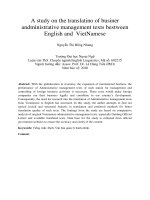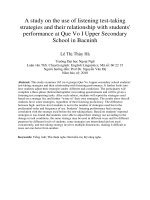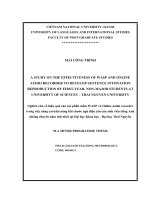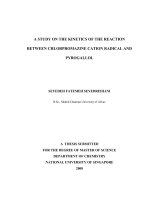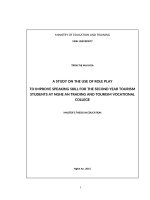Study on the cultivation of chlorella vulgaris and method for cell wall disruption
Bạn đang xem bản rút gọn của tài liệu. Xem và tải ngay bản đầy đủ của tài liệu tại đây (812.82 KB, 52 trang )
VIET NAM NATIONAL UNIVERSITY OF AGRICULTURE
FACULTY OF BIOTECHNOLOGY
----------------
GRADUATE THESIS
TOPIC:
“STUDY ON THE CULTIVATION OF CHLORELLA
VULGARIS AND METHOD FOR CELL WALL
DISRUPTION”
Student: CHU THI PHUONG HOA
Class: K61CNSHE
Code student: 610722
Major: Biotechnology
Instuctor: Assoc. Prof. Dr. Nguyen Duc Bach
HA NOI – 3/2021
DECLARATION
I declare that the information reported in the current thesis is the result of
my own work, except where the reference is made.
I declare that all information and references in this thesis have been clearly
stated the origin, name of author, name of work, time and place of study. I full
responsibility for this declaration.
Hanoi, March
NAME
i
2021
TABLE OF CONTENTS
DECLARATION ................................................................................................ i
TABLE OF CONTENTS .................................................................................... ii
LIST OF FIGURES ........................................................................................... iii
LIST OF TABLES ............................................................................................. v
ABSTRACT ...................................................................................................... 1
PART 1: INTRODUCTION ............................................................................... 2
1.1. Problem statement........................................................................................ 2
1.2. Purpose and requirement .............................................................................. 2
1.2.1. Purpose..................................................................................................... 2
1.2.2. Requirement ............................................................................................. 2
PART 2: LITERATURE REVIEW ..................................................................... 3
2.1. Overview of the Chlorella vulgaris ............................................................... 3
2.2. Morphology and biology characteristics of Chlorella vulgaris ....................... 4
2.2.1. Morphology of Chlorella vulgaris.............................................................. 4
2.2.2. Reproduction of Chlorella vulgaris ............................................................ 5
2.3. Factors affecting the growth and development of Chlorella vulgaris .............. 6
2.3.1. Light......................................................................................................... 6
2.3.2. Temperature.............................................................................................. 6
2.3.3. Salinity ..................................................................................................... 7
2.3.4. pH ............................................................................................................ 8
2.4. Nutritional ingredients of Chlorella vulgaris ................................................. 8
2.5. Functional of active ingredients in Chlorella vulgaris .................................. 11
PART 3: RESEARCH METHODOLOGY ........................................................ 17
3.1. Research subjects ....................................................................................... 17
3.2. Study time and place .................................................................................. 17
3.3. Chemicals.................................................................................................. 17
3.4. Research equipments.................................................................................. 20
ii
3.5. Research methods ...................................................................................... 21
3.5.1. Determination of the cell density by Neubauer chamber............................ 21
3.5.2. Specific growth rate of Chlorella vulgaris ................................................ 22
3.5.3. Preservation of Chlorella vulgaris............................................................ 23
3.5.4. Factors affecting the growth of Chlorella vulgaris .................................... 24
3.5.4.1. Effects of culture media on the growth of Chlorella vulgaris.................. 24
3.5.4.2. Effects of light cycle on the growth of Chlorella vulgaris ...................... 24
3.5.4.3. Effects of light intensity on the growth of Chlorella vulgaris.................. 25
3.5.4.4. Effects of nitrogen concentration on the growth of Chlorella vulgaris .... 25
3.6. Method for cell wall disruption ................................................................... 26
3.7. Data analysis ............................................................................................. 27
PART 4: RESULT AND DISCUSSION............................................................ 28
4.1. Investigation of optimal culture media on the growth of Chlorella vulgaris .. 28
4.2. Investigation of optimal light cycle on the growth of Chlorella vulgaris ....... 30
4.3. Investigation of optimal light intensity on the growth of Chlorella vulgaris .. 33
4.4. Investigation of optimalnitrogen concentration on the growth of Chlorella
vulgaris ............................................................................................................ 35
4.5. Ultrasonication method for cell wall disruption ........................................... 38
PART 5: CONCLUSION AND RECOMMENDATION.................................... 40
5.1. Conclusions ............................................................................................... 40
5.2. Recommendations...................................................................................... 40
REFERENCES................................................................................................. 41
iii
LIST OF FIGURES
Table 2.1. Nutritional components of Chlorella vulgaris .................................. 8
Table 2.2. Compare the protein content of Chlorella vulgaris with other foods.. 9
Table 2.3. Vitamins were found in Chlorella vulgaris .................................... 10
Table 2.4. Fatty acids were found in Chlorella vulgaris.................................. 11
Table 4.1. Cell density of Chlorella vulgaris in different media ...................... 28
Table 4.2. Cell density of Chlorella vulgaris in different light cycle ............... 31
Table 4.3. Cell density of Chlorella vulgaris in different light intensity .......... 33
Table 4.4. Cell density of Chlorella vulgaris in different nitrogen concentration
.................................................................................................................... 36
Table 4.5. Chlorella vulgaris cell disruption by ultrasonication in diferrent
power........................................................................................................... 38
iv
LIST OF TABLES
Fig 2.1. Classification of Chlorella vulgaris..................................................... 3
Fig 2.2. The different phases of daughter cell-wall formation in Chlorella
vulgaris .......................................................................................................... 5
Fig 3.1. Neubauer counting chamber ............................................................. 21
Fig 3.2. Preservation of Chlorella vulgaris. ................................................... 23
Fig 4.1. Growth rate of Chlorella vulgaris in different media ......................... 29
Fig 4.2. Specific growth rate of Chlorella vulgaris in diferent media .............. 29
Fig 4.3. Growth rate of Chlorella vulgaris in different light cycle ................... 32
Fig4.4. Specific growth rate of Chlorella vulgaris in different light cycle ....... 32
Fig 4.5. Growth rate of Chlorella vulgaris in different light intensity .............. 34
Fig 4.6. Specific growth rate of Chlorella vulgaris in different light cycle....... 34
Fig 4.7. Growth rate of Chlorella vulgaris in different nitrogen concentration . 36
Fig 4.8. Specific growth rate of Chlorella vulgaris in different nitrogen
concetration.................................................................................................. 37
Fig 4.9. Cell disruption by ultrasonication of Chlorella vulgaris in different
power........................................................................................................... 39
v
ABSTRACT
Chlorella vulgaris, a green alga that is widely used as a food supplement,
has good antioxidant and therapeutic properties. Studies on cultivation of the
Chlorella vulgaris showed a high nutritional value in proteins of this species,
that could represent a major source of food for human. However, this goal has
not yet been reached due to the very high cultivation costs, which lead to a noncompetitive price compared to other biomass protein sources, such as soy. In
this study, Chlorella vulgaris will be experimented to determine the optimal
culture media, the optimal growth condition such as light cycle, light intensity
and nitrogen concentration. Then based on experimental results to cultivate the
biomass of Chlorella vulgaris algae.
Some methods for disruption cell wall is microwave, enzymatic, grinding
with liquid nitrogen, bead willing and more. In this study, the ultrasonication
method was chosen to disrupt the cell wall of Chlorella vulgaris.
1
PART 1: INTRODUCTION
1.1. Problem statement
Chlorella vulgaris microalgae have high nutritional value. Chlorella
vulgaris are consumed as food supplement and its products are also used for
different purposes like dyes, pharmaceuticals, animal feed, aquaculture and
cosmetics. It also proved to be a source of products such as proteins,
carbohydrates, pigments, vitamins and minerais. In addition, microalgae capture
sunlight and perform photosynthesis by producing approximately half of
atmospheric oxygen on earth and absorbing massive amounts of carbon dioxide
as a major feed. Overall, nutritional demand for algal products of human is
increasing. Stemming from a greater focus on health and wider use of food
additives.
Nowadays, Chlorella vulgaris is popular all over the world, and Japan is
the world leader in consuming Chlorella vulgaris and using it for medical
treatment because it showed to have immune-modulating and anti-cancer
properties. In Vietnam, the consumption and production of Chlorella vulgaris is
still limited because there is very little research and high cost. Foreseeing this
situation, the thesis “Study on the cultivation of Chlorella vulgaris and method
for cell wall disruption” was chosen to determine the optimal conditions for the
growth of Chlorella vulgaris.
1.2. Purpose and requirement
1.2.1. Purpose
Study on cultivation of Chlorella vulgaris and method for cell wall
disruption.
1.2.2. Requirement
Determine the optimal culture media for the growth of Chlorella vulgaris.
Determine the optimal conditions for the growth of Chlorella vulgaris.
Method for cell wall disruption.
2
PART 2: LITERATURE REVIEW
2.1. Overview of the Chlorella vulgaris
Hence, Martinus Willem Beijerinck, a Dutch researcher, first discovered
Chlorella vulgaris in 1890 as the first microalga with a well-defined nucleus.
The name Chlorella comes from the Greek word chloros, which means green,
and the Latin suffix ella referring to its icroscopie size. It belongs to the family
of Chlorellaceae. [Beijerinck M. 1890].
Phylum
• Chlorophyta
Class
• Trebouxiophyceae
Order
• Chlorellales
Family
• Chlorellaceae
Genus
• Chlorella
Species
• Chlorella vulgaris
Fig 2.1. Classification of Chlorella vulgaris
Chlorella vulgaris lives in fresh water and has the highest chlorophyll
content (28.9g/kg) of any known photosynthetic plant. lt is a unicellular
microalgae that has been present on earth since the pre-Cambrian period 2.5
billion years ago and since then its genetic integrity has remained constant.
Chlorella vulgaris is part of a group of eukaryotes in the form of a single cell.
The size of Chlorella vulgaris is equal to the size of human red blood cells.
Under optimal living conditions: plenty of light, clear water and clean air,
Chlorella vulgaris can reproduces at a tremendous speed.
3
2.2. Morphology and biology characteristics of Chlorella vulgaris
2.2.1. Morphology of Chlorella vulgaris
Chlorella vulgaris is a unicellular algae, with no capillary injection, and
does not have active mobility. Cells are spherical or oval in shape. Cell size
ranges from 3 - 5µm, or even 2 - 4µm depending on environmental conditions
and development stage. Cell membranes are encased in cellulose, and that can
resistant to light mechanical stress. Changes in environmental conditions such as
light, temperature, chemical composition in the environment will affect the
morphology and quality of algae cells. [Tran Van Vy. 1995].
Cell wall preserves the integrity of the cell and is basically a protection
against invaders and harsh environment. It varies according to each growth
phase. During its early formation in its autosporangia, the newly formed cell
wall remains fragile, forming a 2 nm thin electron-dense unilaminar layer. The
cell wall of the daughter cell gradually increases in thickness until it reaches 1721 nm after maturation, where a microfibrillar layer is formed representing a
chitosan-like layer composed of glucosamine, which accounts for its rigidity. In
the mature stage, cell wall thickness and composition are not constant because
they can change according to different growth and environmental conditions.
[Yvonne N, Tomas K. 2000].
Chlorella vulgaris has a single chloroplast with a double enveloping
membrane composed of phospholipids; the outer membrane is permeable to
metabolites and ions, but the inner membrane has a more specific function on
proteins transport. Starch granules, composed of amylose and amylopectin, c an
be formed inside the chloroplast, especially during unfavourable growth
conditions. The pyrenoid contains high levels of ribulose-1,5-bisphosphate
carboxylase oxygenase (RuBisCO) and is the centre of carbon dioxide fixation.
The chloroplast also stores a cluster of fused thylakoids where the dominant
pigment chlorophyll is synthesised masking the colour of other pigments such as
4
lutein. During nitrogen stress, lipid globules mainly accumulate in the cytoplasm
and the chloroplast. [Van den Hoek C, Mann D, Jahns H. 1995].
2.2.2. Reproduction of Chlorella vulgaris
Chlorella vulgaris is a non-motile reproductive cell (autospore) that
reproduces asexually and rapidly. Thus, within 24h, one cell of Chlorella
vulgaris grown in optimal conditions multiplies by autosporulation, which is the
most common asexual reproduction in algae. This algae does not have sexual
reproduction. [Yamamoto M, Fujishita M, Hirata A, Kawano S. 2004].
Fig 2.2. The different phases of daughter cell-wall formation in Chlorella
vulgaris
(a) Early cell-growth phase; (b) Late cell-growth phase; (c) Chloroplast
dividing phase; (d) Early protoplast dividing phase; (e) Late protoplast dividing
phase; (f) Daughter cells maturation phase; (g) Hatching phase. [Yamamoto M,
Kurihara I, Kawano S. 2005].
The reproductive process is carried out by creating spores in the mother
cell. Depending on the environmental conditions, the number of spores can be 2,
4, 8, 16, 32 (even 64 spores can be produced). In this manner, daughter cells
having their own cell wall are formed inside the cell wall of the mother cell.
After the division has ended, the spores separate from the mother cell by
damaging the cell wall and the remaining debris of the mother cell will be
consumed as feed by the newly formed daughter cells.. These young cells grow
and develop to the asexually stage, the whole cycle repeating from the
beginning. The life span of chlorella vulgaris is dependent on light intensity,
temperature, and nutrient source. [Agrawal Manisha. S. C., 2007]
5
2.3. Factors affecting the growth and development of Chlorella vulgaris
2.3.1. Light
Light is a factor that has a great influence on the growth of microalgae, and
the main source of energy for the photosynthesis. The effects of light on the
growth are expressed in terms of light quality, light intensity and duration of
illumination. Light intensity that is too large or too small can inhibit algae
photosynthesis. Under laboratory conditions, it is possible to adjust the light
intensity by using neon lights, but when grown outdoors, the sunlight is too
great, so it is necessary to have a roof. Some algae do not grow under constant
light. Continuous light does not increase algal yields, but also reduces the
content of proteins, carbohydrates and unsaturated fatty acids. [Guillard, 1975].
Providing light for the algae culture is essential. Because the coefficient of
light energy of algae is higher than higher plants, which means that they absorb
inorganic carbon to convert to organic carbon. Therefore, under high intensity
light and long lighting time, photo-inhibition phenomenon, which can cause
algae death or significantly reduce culture productivit. Blue light increases the
amount of algae protein while red light increases carbohydrates. The intensity of
light, the duration of the illumination, and the quality of light also depend on the
species and the different stocking density. [Kowallik, 1987]
2.3.2. Temperature
Temperature greatly affects to the growth of all organisms on the earth in
general and for microalgae in particular. For microalgae, temperature affects cell
structure, metabolic reaction rate, photosynthesis, distribution density, intensity
of respiration and cell size. Microalgae can live in the range of 16-30ºC, high
temperatures over 35ºC or lower than 16ºC microalgae are underdeveloped and
can cause death of some species if the temperature threshold is prolonged. The
suitable temperature for microalgae to grow and develop is in the range of 2025ºC. This temperature can vary according to environmental composition and
species.[Filipa Lopes, 2016].
6
For Chlorella vulgaris, if the temperature is below 15ºC and above 35ºC,
then the algae cannot grow. At a temperature of 25-30ºC with good nutritional
conditions, light intensity and suitable stirring, Chlorella vulgaris algae grow
rapidly. In the production of microalgae in the aquaculture farms, the
temperature determines greatly on the yield and quality of microalgae.
Moreover, Vietnam is located in the tropical monsoon area, with great variation
in temperature during the year. Winter temperatures can be up to 5-7 ºC,
summer temperatures can reach 38ºC. Therefore, to ensure the stability and
long-term production, the solution of creating purebred varieties with indigenous
origin is considered to be very effective.[Olivier Bernard, 2016].
2.3.3. Salinity
Each species of microalgae has the ability to adapt to different salinity, but
most species of microalgae are very tolerant of changes in salinity. Chlorella
vulgaris is a salty species that can grow at 5-30 ‰ salinity but it grow best at
25-30‰. The change in salinity will effect the osmotic pressure, limits
photosynthesis, respiration, growth rate, and reduces the accumulation of
glucogen. [Choi-JinYun, Kum-Ok Hwang, Song-Su Han, Hyong-GuanRi. 2019]
Salinity condition had the effect on lipid content of microalgae cultivation.
The effect of salinity concentration on lipid content of Chlorella vulgaris was
observed that the salinity concentration of 0.023, 0.05 and 0.075 M of NaCl
induced to increase lipid content about 4.60%, 1.84% and 3.09%, respectively.
The effluent from frozen seafood industry contained 0.023M of NaCl, the
growth of Chlorella vulgaris with this effluent provided 4.60% of lipid content
that provided the best condition of salinity for Chlorella vulgaris cultivation.
Then, the effluent from frozen seafood industry was suitable for microalgae
growth especially the Chlorella vulgaris due to this effluent contained enough
salinity. It could be concluded that the increased salinity led to enhance lipid
content in Chlorella vulgaris strain. But it was slightly enhanced among various
concentrations of salinity.[Vicheka Keo and Thaniya Kaosol, 2020].
7
2.3.4. pH
An important parameter of the environment is pH because pH determines
the solubility of 𝐂𝐎𝟐 and mineral salts that affect the metabolism in algae. Most
varieties of algae grown in the environment have a certain pH value. With pH
control, the cell density under the light intensity all increased with the increase
of pH, and it was highest with pH control at 10. Moreover, the pH of culture
broth with pH control at 10 fluctuated between 10 an 10.5. That’s mainly
because the pH control refers to daily adjusting the pH, which limits the rising
of pH. It can be suggested that the light intensity will not affect the optimal pH
value. Meanwhile, the pH of culture broth with pH control at 10 fluctuated
between 10 and 10.5, which was the optimal range for the growth of Chlorella
vulgaris. [Celekli A, Donmez G, 2006]
2.4. Nutritional ingredients of Chlorella vulgaris
Chlorella vulgaris is rich in amino acids, complex carbohydrates, vitamins,
minerals, fat (85% unsaturated fatty acids), RNA (over 10%), DNA (over 3%),
chlorophyll, carotenoids, enzymes and polysaccharides (Table 2.3) [Katharina J
W, et. 2019].
Table 2.1. Nutritional components of Chlorella vulgaris
Component
Quantity (mg)
Carbohydrate
10-20
Chlorophyll
3-7
Minerals
5-7
Fat
5-15
Fiber
1-6
Protein
60-69
Water
3-6
8
Chlorella vulgaris contains the highest chlorophyll content of all other
green algae and plants. The amount of Chlorophyll contained in Chlorella
vulgaris is very large about 7% of total weight, 5 - 10 times higher than
Spirulina, and 10 times more than alfalfa. Due to its high level of Chlorophyll,
Chlorella vulgaris is considered a perfect food. It provides a full range of
essential amino acids and non-essential amino acids for humans. Protein in
Chlorella vulgaris is better than protein in meat because it provides easily
digested amino acids to carry out other functions of the body. Chlorella vulgaris
contains a higher protein content than foods obtained. (Table 2.4) [Katharina J
W, et. 2019]
Table 2.2. Compare the protein content of Chlorella vulgaris with other
foods
Other foods
Quantity (mg)
Chlorella vulgaris
60-69
Spirulina
70
Soy bean
32
Wheat
13
Chicken
24
Fish
18-29
Beef
24-27
Egg
13
Rice
3
Chlorella vulgaris is full of vitamins in high concentrations. The folic acid
content is 2 times more than beef, and vitamin B12 is more than beef. Chlorella
vulgaris is a naturally derived food rich in vitamin B3 and vitamin A. It prevents
oxidative free radical formation to protect the body against cancer, slowing
down the aging process. Chlorella vulgaris is one of the products with the
highest chlorophyll and β-carotene content in the world. (Table 2.5) [Katharina J
W, et. 2019].
9
Table 2.3. Vitamins were found in Chlorella vulgaris
Vitamin
Quantity (mg)
α-carotene
24
β-carotene
86
Vitamin B1
2,32
Vitamin B2
5,02
Vitamin B3
24,5
Vitamin B5
1,92
Vitamin B6
2,52
Folic acid
0.560
Vitamin B12
0.008
Biotin
0.230
Choline
0.180
Inositol
0.281
Vitamin C
70
Vitamin D
25259
Vitamin E
14,5
Vitamin K
0.506
It is easy for humans to absorb and use organic minerals. It contains high
levels of potassium, calcium, magnesium and iron, essential for cardiovascular
development, blood formation and blood circulation. In addition, it is also a rich
source of other substances such as fatty acids, lutein and xanthophyll. ( Table
2.6) [Katharina J W, et. 2019].
10
Table 2.4. Fatty acids were found in Chlorella vulgaris
Component
Quantity (mg)
Unsaturated fatty acids
1377
Saturated fatty acids
256
RNA
2950
DNA
280
Lutein
503
Xanthophyll
138
GLA
6
Coenzyme Q9
14
Carotene oil
718
2.5. Functional of active ingredients in Chlorella vulgaris
a. Function of Chlorophyll
Chlorophyll is a natural origin, with long-term use, no side effects and
interactions with other drugs. Chlorophyll eliminate all odors of the body, aroma
the odors of the body secretions. The deodorizing effect is internal and systemic.
It also can inhibit the growth of bacteria, especially anaerobic bacteria (abundant
in the digestive tract and oral cavity, dental plaque), these bacteria are inhibited
by oxygen generated from chlorophyll. Chlorophyll widely used in dentistry,
anti-caries, prevention and treatment of infections before and after tooth
extraction, marrow destruction or dental procedures. Effective in diseases of the
gastrointestinal tract such as bloating inflammation, vomiting, infections in the
digestive tract, purulent colitis, constipation or prolonged diarrhea. Chlorophyll
enhances liver detoxification function. Chlorophyll has a therapeutic effect on
cancer and it also contributes to cancer prevention, due to its ability as an
antioxidant and its ability to form a stable mixture of certain carcinogens when
ingested and before being absorbed into the bloodstream, so that there are no
11
longer harmful to the body. [Gouveia L, Raymundo A, Batista AP, Sousa I,
Empis J, 2005]
b. Function of Omega 3
Omega 3 are unsaturated fatty acids, they include 3 main types: EPA, DHA,
DPA. DHA helps to slow down and prevent the aging process of the brain, the
older people are, the lower DHA content in the brain. For adolescents in
adulthood, DHA helps maintain health, the normal growth of nerve cells, and
memory enhances. Especially those who are stressed, high work pressure, and
intellectual workers, DHA is considered as a very good nutrition for the brain.
For children, DHA helps in nerve and vision development. DPA is an essential
substance for the complete development of the fetus and nerve cells of the fetus.
DPA plays a very important role throughout the baby's prenatal and postnatal
development. EPA help to create Prostaglandin in the blood. This Prostaglandin
works to inhibit platelet clumping, it reduce and prevent the formation of blood
clots, it reduce cholesterol, it reduce blood triglycerides, it reduce blood
viscosity, and it keep circulation, ventilation. EPA also works to reduce
atherosclerosis. Therefore, EPA is effective for the prevention and treatment of
cardiovascular diseases caused by atherosclerosis. [Seyfabadi J, Ramezanpour
Z, Amini Khoeyi Z, 2011]
c. Function of β-carotene
β-c arotene is a precursor to vitamin A, and it is a rich natural source of
vitamin A for the body. Vitamin A plays a role in visual ability and children's
development, so it also works to brighten the eyes and looks more refined, good
for kids and the elder. It also has the function of strengthening the immune
system so it is good for new person recovered from illness. Besides, β-carotene
also possesses a preeminent antioxidant ability because it works to eliminate
excess free radicals in the body. This free radicals seriously damage cell
membranes, it damages organelles, it is closely related to the aging process,
12
deterioration of beauty, youth, it is also the cause. Many diseases do not have an
official solution like cancer. So with beta carotene we can avoid all of these
things, protecting cell membranes, slowing down aging and preventing cancer.
[Gonzalez LE, Bashan Y, 2000]
d. Function of cacbohydrates
Carbohydrates represent a group of reducing sugars and polysaccharides
such as starch and cellulose. Starch is the most abundant polysaccharide in
Chlorella vulgaris. Starch is generally located in the chloroplast and it compose
amylose, amylopectin, and sugars. All of them serve as energy storage for the
cells. Cellulose is a structural polysaccharide with high resistance, which is
located on the cell wall of Chlorella vulgaris as a protective fibrous barrier. In
addition, one of the most important polysaccharides present in Chlorella
vulgaris is the β1to 3 glucan, which has multiple health and nutritional benefits.
Total carbohydrates are generally quantified by the sulphuricphenol
method, yielding simple sugars after hydrolysis at 110 °C, then quantification of
the latter by HPLC ( especially HPIC). Starch quantification is much better
using the enzymatic method compared to the acidic method. During nitrogen
limitation, total carbohydrates can reach 12-55% dry weight. Moreover,
Chlorella vulgaris has a remarkably robust cell wall, mainly composed of a
chitosan like layer, cellulose, hemicellulose, proteins, lipids and minerais. The
sugar composition of the cell wall is a mixture of rhamnose, galactose, glucose,
xylose, arabinose and mannose, rhamnose being the dominant sugar. [Takeda H,
1988].
e. Function of vitamin E
Vitamin E join the metabolism of cells, it protect vitamin A and fatty acids
from oxidation, erythropoiesis, prevent cell damage, help the body use vitamin
K and prevent atherosclerosis by reducing oxidation of fat-soluble proteins,
thereby preventing these proteins from participating in the process of clogging
of the arteries. Vitamin E prevents cardiovascular diseases, including
13
myocardial infarction and cerebral vascular accident, by reducing the
aggregation of bad cholesterol low density lipoprotein in the blood vessels.
Vitamin E can increase immunity by protecting cells from damage, thereby
increasing the body's resistance to stronger bacterial infections. Vitamin E
reduces the risk of cataracts due to its antioxidant properties. Vitamin E is
absorbed in the small intestine along with other vitamins such as A, D, and K.
About 35% of vitamin E was absorbed into the body had transferred to the
lymph, the rest is excreted in the stool. Vitamin E circulates in the bloodstream
and is stored mainly in the liver, adipose tissue, a small part in the pituitary,
adrenal glands, testicles, and uterus. Vitamin E does not cause poisoning when
used in large amounts. [Abeille D’Or, 1989].
2.6. Application of Chlorella vulgaris in functional foods
Chlorella vulgaris is considered a functional food popular in Japan because
it contains all the nutrients needed by the human body and it can perform many
therapeutic functions in the body. The nutrients in Chlorella vulgaris interact
with the body's systems, promoting healing, balancing and revitalizing.
Chlorella vulgaris can provide important nutrients that are lacking in the human
diet. Furthermore, the natural vitamins and minerals in Chlorella vulgaris
combine with amino acids, helping the body to easily absorb and perform
metabolic processes. [Liang S, Liu X, Chen F, Chen Z, 2004].
Here are some effects of functional foods related to Chlorella vulgaris to
human health. Due to the high chlorophyll content, Chlorella vulgaris can clean
the intestines, clean the blood, and it has a positive effect on the function of the
liver and kidneys. Therefore, it increases the ability to filter blood and increase
the body's resistance, treat common cold and flu. Chlorella vulgaris stimulates
the activity of lymphocytes and macrophages and increases interferon levels. So
it strengthens the immune system's ability to fight foreign pathogens and
proteins. Chlorella vulgaris is a natural food rich in nucleosides and nucleotides
with ingredients that are good for brain development. Chlorella vulgaris is
14
capable of excreting toxins very well such as cadmium - a heavy metal found in
tobacco. Several scientific studies have shown that vitamin A and 𝛃-carotene
contained in Chlorella vulgaris improve the immune system's abilities, aid in
cancer prevention, prevention and treatment. β-carotene and vitamin E in the
elimination of cancer risk in the early stages. A diet high in sodium and low in
potassium increases the risk of high blood pressure. In contrast, a diet high
in potassium and low in sodium can lower blood pressure. The easiest way
to get lower sodium is to avoid ready-to-eat foods and table salt, and
consume foods high in potassium such as Chlorella vulgaris. [Liang S, Liu
X, Chen F, Chen Z, 2004]
Chlorella vulgaris is known to be one of the food sources with the highest
concentration of nucleic acids. Chlorella vulgaris is rich in antioxidants, such as
carotenoids, vitamins C and E, chlorophyll and selenium, which help prevent
premature aging by neutralizing free radicals in the body. Chlorella vulgaris
helps control weight by providing a large amount of essential nutrients and it
reduce cravings. Incorporating Chlorella vulgaris during weight loss will bring
balance to the endocrine system, improve the efficiency of weight loss.
Chlorella vulgaris is known to be a good source of Lutein, a group of
Carotenoids that are known to help prevent and treat macular degeneration. In
facts, 80% of diabetics have low magnesium levels. By enriching the amount of
magnesium, Chlorella vulgaris can help normalize blood sugar. [Liang S, Liu X,
Chen F, Chen Z, 2004]
Chlorella vulgaris has a very important role in skin beauty. The people who
use Chlorella vulgaris can get a much younger looking skin in just a few weeks.
Because Chlorella vulgaris is rich in nucleic acid that restores the skin and
protects them from the effects of free radicals that cause signs of aging. Besides
nucleic acid, Chlorella vulgaris is also rich in Lysine, an amino acid that creates
collagen and it promotes youthful skin. -carotene, carotenoids, vitamin E, and
fatty acids in this algae help restore aging skin, smooth wrinkles and lighten age
15
spots. Besides, the chlorophyll and its derivatives keep the skin bright and
healthy. Furthermore, Chlorella vulgaris is rich in fiber, which helps the body to
digest and absorb nutrients optimally to create healthy cells for a younger,
beautiful skin. [Liang S, Liu X, Chen F, Chen Z, 2004]
16
PART 3: RESEARCH METHODOLOGY
3.1. Research subjects
Determination of the optimal culture media for the growth of Chlorella
vulgaris
Determination of the optimal conditions for the growth of Chlorella
vulgaris
Method for cell wall disruption.
3.2. Study time and place
The thesis was done at the laboratory of Department of Biotechnology
Vietnam National University of Agriculture. Thesis was occur from August
2020 to January 2021.
3.3. Chemicals
BBM - Bold's Basal Medium is a freshwater algae medium that has been
used to grow a variety of green algal cultures (Trichosarcina, Chlorococcum,
and Chlorella) without the need for soil-extract or vitamins. [Brown et al., 1964;
Nichols and Bold, 1965].
Stock Solution
(g.l-1 dH2O)
Quantity Used
(mL/L)
NaNO3
25.00
10
CaCl2.2H2O
MgSO4.7H2O
2.50
7.50
10
10
K2HPO4
KH2PO4
7,50
17.50
10
10
NaCl
2.50
10
EDTA solution
see following recipe
1.0
Acidified iron solution
see following recipe
1.0
11.42
1.0
see following recipe
1.0
Component
H3BO3
Trace metals solution
17
EDTA solution
Component
Quantity Used (g/L)
EDTA
50
KOH
31
Acidified Iron Solution
Component
Quantity Used (g/L)
FeSO4.7H2O
0.498
H2SO4 (96%)
0.1(ml)
Trace metals solution
Component
Quantity Used (g/L)
ZnSO4.7H2O
8.82
MnCl2.4H2O
1.44
MoO3
0.71
CuSO4.5H2O
1.57
Co(NO3)2.6H2O
0.49
18
F/2 media is a common and widely used general enriched seawater
medium designed for growing coastal marine algae, especially diatoms.
[Guillard and Ryther 1962].
Stock Solution
Quantity Used
(g.l-1 dH2O)
(ml/L)
𝐍𝐚𝐍𝐎𝟑
75
1
𝐍𝐚𝐇𝟐 𝐏𝐎𝟒 .H2O
5
1
𝐍𝐚𝟐 𝐂𝐎𝟑
30
1
Trace Metal Solution
see following recipe
1
Vitamin Solution
see following recipe
0.5
Component
Trace metal solution
Component
Quantity Used (g/L)
𝐅𝐞𝐂𝐥𝟑 . 𝟔H2O
3.15
𝐍𝐚𝟐 𝐄𝐃𝐓𝐀.2H2O
4.36
𝐂𝐮𝐒𝐎𝟒 . 𝟓H2O
1(ml)
𝐍𝐚𝟐 𝐌𝐨𝐎𝟒 . 𝟐H2O
1(ml)
𝐙𝐧𝐒𝐎𝟒 . 𝟕H2O
1(ml)
𝐂𝐨𝐂𝐥𝟐 . 𝟔H2O
1(ml)
𝐌𝐧𝐂𝐥𝟐 . 𝟒H2O
1(ml)
Vitamin solution
Component
Quantity Used (mg/L)
Thiamine HC
200
Biotin
10(ml)
Cyanocobalamin
1(ml)
19

